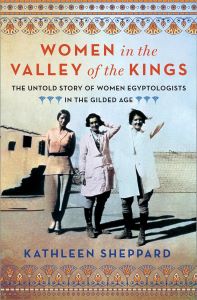
Book Review
Women in the Valley of the Kings by Kathleen Sheppard
History | Non-Fiction
Reader’s Thoughts:

The history of Egyptology has historically focused on the men who competed in uncovering artifacts for their homelands. But during the Golden Age of Exploration, there were also women working, exploring, and traveling through Egypt — long before Howard Carter discovered King Tut’s tomb. In Women in the Valley of the Kings: The Untold Story of Women Egyptologists in the Gilded Age, Kathleen Sheppard serves to highlight and uncover the lives of more than eleven different women who played key roles in early Egyptology.
Broken into sections following the lives of various women in the field, Sheppard strives to show how each woman not only set up success for women Egyptologists coming after her but also changed the field of Egyptology forever. Sheppard is well-versed in this part of history and has done an incredible amount of research into each of the women in this book — a feat given that there is clearly a lack of information about their work, especially in comparison to their male counterparts.
While the writing is sometimes a little dry, it was interesting to see the evolution of the field. In the early days of exploration, there was very little expertise. In fact, the author notes that all you needed to be an archeologist at that time was time to travel and enough money to fund a dig or purchase artifacts. The women discussed in these seven sections each played a unique role in the history of Egyptology and I applaud Sheppard for highlighting them, faults and all, as they each strove to further the field.
As someone who is fascinated by untold stories of women throughout history, this non-fiction read on female Egyptologists in the Gilded Age naturally appealed to me. However, I will admit that this is not a normal area of study for me, and I knew very little about Egyptology in the 19th and early 20th centuries. As such, this book did take me a while to work through as there were a lot of names, places, and details that were occasionally challenging to keep track of — and thus, led to chapters where my attention waned. While the subject was certainly interesting to learn about, as a layperson, I think this book may offer greater appeal to those who come into it with a deeper foundation and knowledge of the topic.
Overall though, I’m grateful for the opportunity to learn about these women and the work they accomplished, and I think Sheppard has done a good job compiling this into a unified story that will appeal to historians and those with a specific interest in the topic.
Recommended for:
Readers interested in the history of women in Egyptology
This post contains affiliate links; as an Amazon associate, I earn from qualifying purchases. Advance copy of the book provided courtesy of the publisher, St. Martin’s Press. All opinions expressed are my own.
About the book:
(From the publisher): The history of Egyptology is often told as yet one more grand narrative of powerful men striving to seize the day and the precious artifacts for their competing homelands. But that is only half of the story. During the Golden Age of Exploration, there were women working, exploring, and traveling long before Howard Carter discovered the tomb of King Tut. Before men even conceived of claiming the story for themselves, women were working in Egypt to lay the groundwork for all future exploration.
In Women in the Valley of the The Untold Story of Women Egyptologists in the Gilded Age of Exploration Kathleen Sheppard brings these women back into the narrative and tells their stories that were often deliberately left out and forgotten by time. Sheppard begins this never-before-told narrative with the earliest European women who ventured to Egypt as Lucie Duff Gordon, Amelia Edwards, and Marianne Brocklehurst. Their travelogues, diaries and maps chronicled a new world for the curious. In the vast desert, Maggie Benson, the first woman granted permission to excavate in Egypt, met Nettie Gourlay, the woman who became her lifelong companion. They battled issues of oppression and exclusion and, ultimately, are credited with excavating the Temple of Mut.
As each woman scored a success in the desert, she set up the women who came later for their own struggles and successes. Emma Andrews’ great success as a patron and archaeologist helped to pave the way for Margaret Murray to be able to teach women to go into the field. Murray’s work in the university led to the artists Annie Quibell and Nina de Garis’s ability to work on site, creating brilliant reproductions of tomb art, and to Kate Bradbury and Caroline Ransom being able to have leadership positions in central institutions. In Women in the Valley of the Kings, Kathleen Sheppard upends the grand male narrative of Egyptian exploration and shows how a group of courageous women charted unknown territory and changed the field of Egyptology forever.
